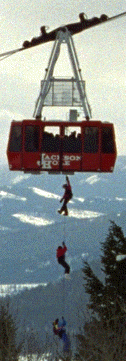March 11, 1996
On Friday, Feb. 23 at approximately 10:35 a.m., a cable on the aerial tram at Jackson Hole Resort de-roped, stranding 63 skiers inside the tram car. Five hours later, the last of the 63 were finally evacuated. The evacuation involved lowering skiers three at a time with harnesses 210 feet to the ground.

The dramatic evacuation occurred with no injuries. Eight days later, on March 2, the tram, after extensive testing, was back in action.
The two-car tram has been in operation since 1963. Similar incidents have occurred only twice before, in 1976 and 1990, both during the summer, said Jim Gill, executive vice president-general manager of Jackson Hole Ski Corp.
According to Jackson Hole Ski Corp., the incident was the result of three elements occurring at the same time. “An emergency stop occurred while the tram was accelerating. The tram car was fully loaded when the brakes were applied and came to an abrupt stop, putting enough slack into the system to allow for a large oscillation of the haul rope behind the car. The haul rope was blown by the wind outside the track ropes and a length of it fell to the ground.”
Earlier that morning, a tram ride up the mountain (on which this writer was aboard) was stopped midway because of pressure on the doors. Sixty-three people are packed into each tram car and taken to the summit of Jackson Hole Ski Resort.
 On-mountain sources said the de-ropement was accompanied by significant movement of the tram car itself. In an interview with Cyberwest Magazine, Gill said the evacuation began at approximately 12:20 p.m. “In between the derailment and the beginning of the evacuation, we took care to inspect Tower 1 and secure the haul rope to the tower … We had to be very careful before we began the evacuation.” Gill credited the tram operator, a Jackson Hole staffer, with keeping everyone aboard calm. He added, “We train for this all the time.”
On-mountain sources said the de-ropement was accompanied by significant movement of the tram car itself. In an interview with Cyberwest Magazine, Gill said the evacuation began at approximately 12:20 p.m. “In between the derailment and the beginning of the evacuation, we took care to inspect Tower 1 and secure the haul rope to the tower … We had to be very careful before we began the evacuation.” Gill credited the tram operator, a Jackson Hole staffer, with keeping everyone aboard calm. He added, “We train for this all the time.”
While the evacuation was taking place, head of tram maintenance Otis Norris made a dramatic climb of the cable to the tram car from Tower 1, a distance of approximately 1,000 feet. Norris was trying to assess the condition of the cable and car.
The incident was not surprising to one Snow King Ski Area staffer who said it “was merely a matter of time” before something happened. Gill countered that this perception was “very inaccurate. The tram has received the best of care, and we’re continuing to invest a lot of money into it.”
“We took some time to study what conditions were present” when the tram de-roped, said Gill. Lift engineers from the ski industry, the ski resort’s insurance carrier, the U.S. Forest Service and the tram design engineer were all consulted throughout the week-long testing, which included inspections of the haul rope, tram car and entire mechanical mechanism. Loads of 110 percent of normal were successfully tested before the tram resumed operation.
Jackson Hole was not the only Rocky Mountain resort beset by lift problems recently. On Monday, March 4, according to the Rocky Mountain News, the weld securing Snowmass’ Sheer Bliss lift tower to its foundation split around 70 percent of its circumference. Two chairs on the lift dropped to the ground and 143 passengers had to be evacuated.
David Iler